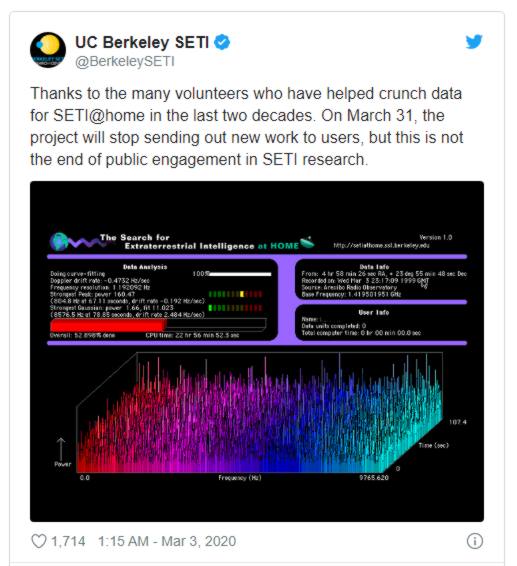| SETI@home Goes Into Hibernation |
| Written by Sue Gee | |||
| Saturday, 07 March 2020 | |||
|
After over 20 years of using thousands of personal computers around using the world to analyze signals coming from outer space to locate traces of life beyond Earth, the SETI@home program has as much data as it can handle and is going into hibernation, calling a temporary halt to further volunteer analysis.
The software, runs either as a screensaver or continuously in the background while a user works, making use of any spare processor time. The original "classic" program, designed to utilize 50,00-100,000 home computers, ran from May 17, 1999 to December 15, 2005 and was the basis for its replacement, BOINC (Berkeley Open Infrastructure for Network Computing) which has attracted many other distributed computing projects. In June 2018 Wikipedia recorded that BOINC brings together about 311,742 active participants and 834,343 active computers, processing on average 26.431 PetaFLOPS, making it the fourth largest processing capability in the world. Announcing that no further tasks would be distributed after March 31st, the project team at UC Berkeley provided two reasons:
Referring to this cessation as "hibernation" the team says that the project is not disappearing and that the project website and message boards will continue to operate. Participants are encouraged to contribute to other BOINC-based projects or to use Science United, also operated by the BOINC project, to continue in astronomy or in physics, biomedicine, mathematics, and environmental science. As Seti@Home currently has about 1.8 million users and an average of 148,000 machines that run the software this should be a big boost to other BOINC projects in number theory, astronomy, climate change, chemistry, life sciences, AI, geology and even cryptography.
More InformationRelated ArticlesUse That Spare Android Time To Solve World Problems - BOINC The 42 Question Answered By Planet-Sized Computer To be informed about new articles on I Programmer, sign up for our weekly newsletter, subscribe to the RSS feed and follow us on Twitter, Facebook or Linkedin.
Comments
or email your comment to: comments@i-programmer.info |
|||
| Last Updated ( Saturday, 14 March 2020 ) |

 As we all know, SETI stands for Search for Extraterrestrial Intelligence, looking for life on other planets and it is an endeavour that has excited the imagination of researchers and the general public alike. Since 1999 one way of being involved in this quest has been to join in "SETI@home" run under the auspices of the University of Berkeley, which is the best known example of distributed computing. Having had over 5.2 million participants worldwide (according to Wikipedia) it attracted more followers than any other distributed computing project.
As we all know, SETI stands for Search for Extraterrestrial Intelligence, looking for life on other planets and it is an endeavour that has excited the imagination of researchers and the general public alike. Since 1999 one way of being involved in this quest has been to join in "SETI@home" run under the auspices of the University of Berkeley, which is the best known example of distributed computing. Having had over 5.2 million participants worldwide (according to Wikipedia) it attracted more followers than any other distributed computing project.

